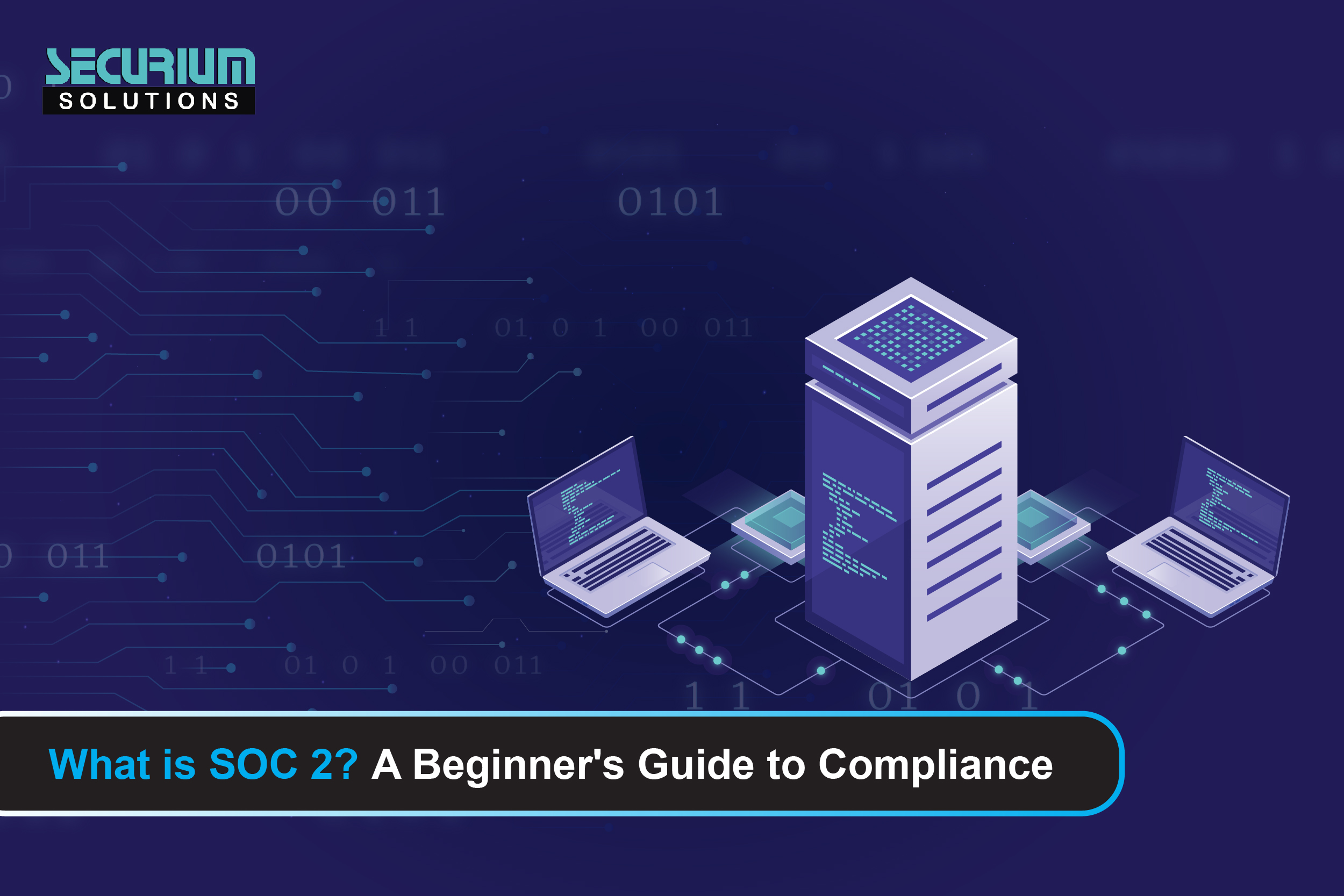What is SOC 2 Compliance? A Beginner’s Guide
In today’s ever-evolving landscape of cybersecurity, where safeguarding sensitive information is not up for negotiation, Securium Solutions emerges as a distinguished expert in cybersecurity services, placing a premium on quality over quantity. Let’s delve into a comprehensive guide to SOC 2 compliance, tailored in plain and straightforward English for beginners. Securium Solutions has garnered the trust of its clients through a proven track record of delivering exceptional results and an unwavering commitment to innovation.
What is SOC Compliance?
In the dynamic realm of cybersecurity, Service Organization Control (SOC) plays a pivotal role. It encompasses a set of standards designed to evaluate how effectively a service organization manages and secures its data. SOC compliance comprises three main reports: SOC 1, SOC 2, and SOC 3.
SOC 1: Concentrates on internal controls related to financial reporting.
SOC 2: Focuses on data security, encompassing aspects like security, availability, processing integrity, confidentiality, and privacy.
SOC 3: Resembles SOC 2 but provides a more concise, publicly accessible overview.
SOC 2 is especially pertinent for technology and cloud organizations entrusted with customer data. It assures that these entities have robust security measures, assessed and verified by an independent third party.
What is SOC 2?
SOC 2, short for Service Organization Control 2, serves as a framework for managing and securing sensitive data in the cloud. It offers assurance to stakeholders regarding the security, availability, processing integrity, confidentiality, and privacy of information within a service organization.
Key Points about SOC 2:
Trust Service Criteria: SOC 2 revolves around five Trust Service Criteria:
1. Security: Protection against unauthorized access.
2. Availability: Ensuring system, product, or service accessibility.
3. Processing Integrity: Guaranteeing accurate, timely, and authorized system processing.
4. Confidentiality: Safeguarding designated confidential information.
5. Privacy: Managing personal information in compliance with privacy commitments.
Audit and Certification: Achieving SOC 2 audit compliance necessitates a thorough examination by an independent third-party auditor, validating that the organization’s controls and processes meet the specified criteria.
Continuous Monitoring: SOC 2 compliance demands ongoing dedication, involving continuous monitoring and enhancement of security practices to maintain certification.
Applicability: While SOC 1 focuses on financial reporting, the SOC 2 report is especially relevant for technology and cloud computing organizations entrusted with customer data.
In essence, SOC 2 serves as a comprehensive standard ensuring that companies handling sensitive data in the cloud adhere to stringent security and privacy measures.
Distinguishing SOC 1 and SOC 2 Compliance:
While SOC 1 primarily addresses financial reporting controls, SOC 2 is tailor-made for technology and cloud computing organizations. Their focus areas differ, with SOC 2 being more pertinent for those responsible for client information and data.
SOC 1 Example: A company providing payroll processing services assures clients of controls to maintain the accuracy of financial data.
SOC 2 Example: A cloud service provider storing and processing customer data showcases robust security measures, system availability, and privacy commitment through SOC 2 audit compliance.
The choice between SOC 1 and SOC 2 hinges on the nature of services and specific client concerns. Many companies opt for both if their services impact financial reporting and data security/privacy.
Who Requires SOC 2 Compliance:
SOC 2 compliance is particularly relevant for technology and cloud computing organizations, including:
– Cloud Service Providers (CSPs) offering cloud services, hosting, or data storage.
– Software as a Service (SaaS) Providers delivering internet-accessed software solutions.
– Data Centers housing computing systems, storage, and networking infrastructure.
– Managed Service Providers (MSPs) managing a customer’s IT infrastructure remotely.
– IT Consulting Firms offering IT consulting, advisory, or outsourcing services.
– Healthcare Providers, especially those using cloud services for electronic health records (EHR) or patient-related data.
– Any Organization Handling Customer Data, including entities storing, processing, or transmitting sensitive customer information.
The necessity for SOC 2 compliance depends on the nature of services provided and the level of trust and assurance clients or stakeholders seek regarding their data’s security, availability, processing integrity, confidentiality, and privacy.
SOC 2 Compliance Requirements:
Achieving SOC 2 compliance entails meeting specific requirements outlined in the Trust Service Criteria. Key elements include:
Security:
– Implementing access controls.
– Protecting against unauthorized access.
Availability:
– Ensuring systems, products, or services are available as committed or agreed.
Processing Integrity:
– Providing assurance of complete, valid, accurate, timely, and authorized system processing.
Confidentiality:
– Protecting designated confidential information.
Privacy:
– Handling personal information in compliance with privacy commitments.
Additional considerations encompass risk management, incident response, and continuous improvement to align with trust service criteria.
SOC 2 Compliance Checklist:
Though comprehensive, a SOC 2 checklist covers key areas such as:
Security:
– Access controls and identity management.
– Data encryption (in transit and at rest).
– Regular security training for employees.
Availability:
– System and network monitoring.
– Redundancy and failover procedures.
– DDoS protection measures.
Processing Integrity:
– Data validation and integrity checks.
– Change management processes.
Confidentiality:
– Data classification and handling policies.
– Encryption and tokenization of sensitive data.
Privacy:
– Privacy policies and procedures.
– Consent management for data processing.
Risk Management:
– Risk assessment documentation.
– Risk mitigation plans and procedures.
Incident Response:
– Incident response plan documentation.
– Logging and monitoring of security events.
Documentation:
– Comprehensive policies and procedures manual.
– Records of employee training on security and compliance audits.
Third-Party Management:
– Due diligence for third-party vendors.
– Contracts with third parties, including security and compliance audit services requirements.
Continuous Monitoring and Improvement:
– Regular security assessments and audits.
– Continuous improvement plans based on audit findings.
Audit Preparation:
– Documented evidence of compliance audit with each trust service criteria.
– Pre-audit preparation and coordination with the auditing firm.
This checklist, though a starting point, underscores the need to customize it to specific processes, risks, and industry regulations. Collaborating with a qualified auditor is essential for a comprehensive assessment and achieving SOC 2 checklist compliance.
What is SOC as a Service:
SOC as a Service, or Security Operations Center as a Service, emerges as a cybersecurity solution offering outsourced monitoring, detection, and response to security incidents. Leveraging the capabilities of a Security Operations Center (SOC) enhances an organization’s security posture without the need for an in-house SOC network.
Key Features of SOC Services:
– 24/7 Monitoring: Continuous monitoring of an organization’s IT infrastructure for security events and incidents.
– Incident Detection: Utilizing advanced technologies to identify potential security threats.
– Incident Response: Prompt response to security incidents, including investigation, containment, and mitigation.
– Threat Intelligence: Integration of threat intelligence feeds to stay informed about the latest cyber threats.
– Log Management: Collecting, analyzing, and managing logs generated throughout an organization’s technology infrastructure.
– Security Analytics: Utilizing advanced analytics and machine learning to identify patterns indicative of potential security issues.
– Compliance Monitoring: Ensuring security practices align with regulatory requirements and industry standards.
By employing Managed SOC Services, organizations gain access to the expertise of security professionals, advanced security technologies, and scalability without significant upfront investments.
Conclusion:
Beyond being a legal requirement, SOC 2 compliance signifies a commitment to safeguarding sensitive data in the digital age. It attests to a company’s dedication to confidentiality, privacy, processing integrity, availability, and security. Organizations entrusted with client data find that maintaining SOC 2 compliance is an essential security measure as technology and cyber threats continue to evolve. SOC 2 compliance services have become a prerequisite in the field of cybersecurity for any business handling client data, whether as a software-as-a-service provider, cloud service provider, or any other role.
If you like this post then read more articles here…







